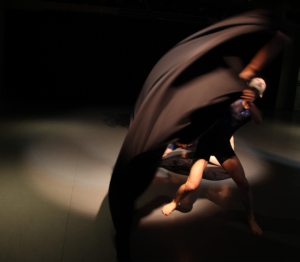By Laurie Cameron, Registered Movement Pattern Analyst

My choreographic process has always involved collaborative research – studio time in which “problems” that I have invented (usually based on a theme) are solved in various ways by the artists who will eventually perform whatever eventually materializes. As the director of the process, my job is to organize and orchestrate largely improvised material into some kind of coherent, presentable form.
With strong motivations in both Timing and Anticipating, it has always been important to me to move the process toward a “finished product” in a timely fashion, assuming that all involved trusted me to make sound artistic decisions and hoping to avoid hours of grueling studio work that might not necessarily produce more interesting results.
During my Movement Pattern Analysis training, I had the opportunity to profile three movement artists – a traditional, highly trained modern dancer, a B-Boy, and a Corporeal Mime practitioner. I was impressed by the diversity of their skills, their interest in self-growth, and their willingness to dive headlong into the choreographic unknown with me. I was even more intrigued by the profile initiatives that they shared, particularly high Investigating and Evaluating, and low-to-moderate Commitment. At the time I anticipated the challenge of moving them out of the Attention and Intention stages to commit to a final product. I did not expect to lose control of the process in such a meaningful and productive way.
I had anticipated three months of studio research followed by an informal showing, more editing, and eventually a fully realized performance about six months later. Instead, the energy to dig deeply, evaluate, reinvent and reimagine took over. All three performers seemed perfectly happy to mine material and critically assess for hours at a time with no performance agenda in sight. For me, the satisfaction of watching the work grow deeper and more refined validated the assessment process. I found my own moderate Evaluating being nourished while my urge to push the piece to completion seemed to relax. We worked in the studio for more than a year before my urge to set a finished piece took hold.
Of all the works I have directed, I am proudest of this. The images suggested by the myths of the Black Sea are, to me, fully realized, and the performers are deeply in tune with each other and with the material they grew with for so long. This process would likely have followed the same course regardless of my knowledge of MPA, but the awareness I now have of the potential for fruitful creative interaction based on decision-making preferences can inform my choreographic process in ways I had never predicted.

 In the preface to Choreutics, Laban defines “choreography” as the “designing or writing of circles.” While we use the word today to designate composing dances, Laban was obviously familiar with the origins of the term, which come from two Greek words – khoros and graphein.
In the preface to Choreutics, Laban defines “choreography” as the “designing or writing of circles.” While we use the word today to designate composing dances, Laban was obviously familiar with the origins of the term, which come from two Greek words – khoros and graphein.